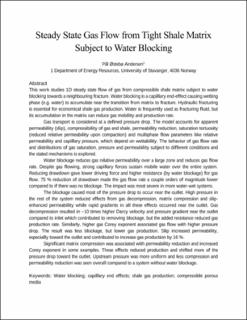| dc.description.abstract | This work studies 1D steady-state flow of gas from compressible shale matrix subject to water blocking toward a neighboring fracture. Water blocking is a capillary end effect causing wetting phase (e.g., water) to accumulate near the transition from matrix to fracture. Hydraulic fracturing is essential for economical shale gas production. Water is frequently used as fracturing fluid, but its accumulation in the matrix can reduce gas mobility and production rate.
Gas transport is considered at a defined pressure drop. The model accounts for apparent permeability (slip), compressibility of gas and shale, permeability reduction, saturation tortuosity (reduced relative permeability upon compaction), and multiphase flow parameters like relative permeability and capillary pressure, which depend on wettability. The behavior of gas flow rate and distributions of gas saturation, pressure, and permeability subject to different conditions and the stated mechanisms is explored.
Water blockage reduces gas relative permeability over a large zone and reduces the gas flow rate. Despite gas flowing, strong capillary forces sustain mobile water over the entire system. Reducing drawdown gave lower driving force and higher resistance (by water blockage) for gas flow. The results show that 75% reduction of drawdown made the gas flow rate a couple orders of magnitude lower compared to if there was no blockage. The impact was most severe in more water-wet systems.
The blockage caused most of the pressure drop to occur near the outlet. High pressure in the rest of the system reduced effects from gas decompression, matrix compression, and slip-enhanced permeability, whereas rapid gradients in all these effects occurred near the outlet. Gas decompression resulted in an approximately 10 times higher Darcy velocity and pressure gradient near the outlet compared to inlet, which contributed to removing blockage, but the added resistance reduced the gas production rate. Similarly, higher gas Corey exponent associated gas flow with higher pressure drop. The result was less blockage but lower gas production. Slip increased permeability, especially toward the outlet, and contributed to increase in gas production by 16%.
Significant matrix compression was associated with permeability reduction and increased Corey exponent in some examples. These effects reduced production and shifted more of the pressure drop toward the outlet. Upstream pressure was more uniform, and less compression and permeability reduction were seen overall compared to a system without water blockage. | en_US |
